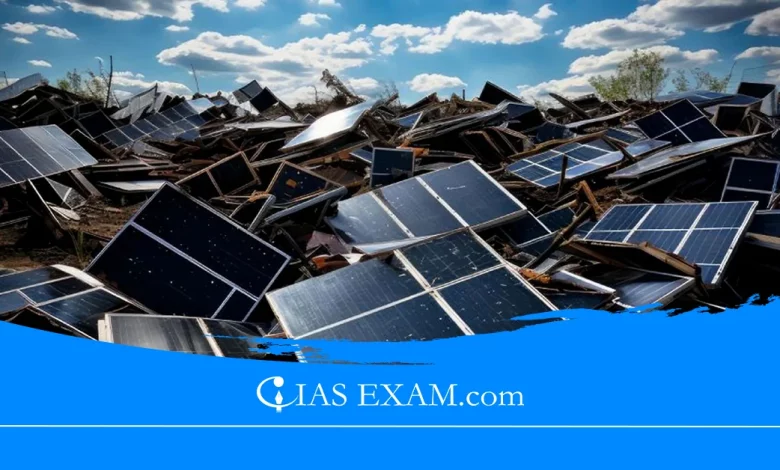
Context
According to a study published by Council on Energy, Environment and Water (CEEW) in collaboration with the Ministry of New and Renewable Energy (MNRE), India’s solar waste could reach 600 kilotonnes by 2030
Key Findings
- Waste Generation: India’s installed 66.7 gigawatt (GW) capacity, as of FY23, has generated about 100 kilotonnes (kt) of cumulative waste, which will increase to 340 kt by 2030.
- This volume will increase 32 times by 2050 resulting in about 19000 kt of cumulative waste.
- States Contribution: Around 67 percent of this waste is anticipated to be generated in 5 states: Rajasthan, Gujarat, Karnataka, Tamil Nadu and Andhra Pradesh.
- Rajasthan will account for 24 percent of the waste generated by 2030, followed by Gujarat accounting for 16 percent, and Karnataka accounting for 12 percent.
India’s Solar Capacity
- Globally, India has emerged as a tremendous player in renewable energy, ranking 4th in overall renewable energy capacity additions and fifth in solar power capcapacity.
- From 2014 to 2024, India also saw an growth in its set up potential for electricity technology, growing from 3.Seventy four GW in FY 2014-15 to 74.31 GW in FY 2023-24 (till January).
- It is slated to jump to 292 GW of installed solar capacity by 2030.
Solar Waste
- Solar waste refers to the waste generated at some point of the manufacturing of solar modules and waste from the sector (project lifetime).
- Manufacturing involves two streams of waste, which include the scrap that’s produced and the waste generated from PV modules failing quality tests.
- Waste from the field entails 3 streams of waste.
- Waste generated during transporting and managing — the broken modules are considered as waste.
- Waste produced due to the damage incurred by solar modules during their lifetime.
- When the modules attain their reach their end-of-life and are not usable anymore.
- The study only focused on waste from the field (project lifetime) category and excluded waste generated during manufacturing.
Key Recommendations
- The policymakers should keep a comprehensive database of the installed solar capacity, which might help in estimating solar waste in the following years.
- The MoEFCC should issue suggestions for amassing and storing solar waste.
- Furthermore, it should also promote secure and efficient processing of saved waste.
- Solar cellular and module producers have to start growing waste collection and storage centres to adhere to the responsibilities assigned in the E-waste Management Rules 2022.
- Policymakers have to incentivise recyclers, and push stakeholders to effectively control the growing solar waste.
Solar Waste Recycling Methods
- Conventional Recycling or Bulk Material Recycling: It includes mechanical approaches like crushing, sieving, and shearing of the waste.
- While the majority of recycled substances include glass, aluminium, and copper, more valuable materials like silver and silicon can not be recovered through this approach.
- High Value Recycling: It includes the usage of a combination of mechanical, chemical, and thermal tactics to recycle the modules.
- Unlike traditional recycling, this approach can recover silver and silicon also with the help of chemical approaches.
India’s Solar Waste Management Policy
- The control of waste generated from solar PV modules, panels and cells is part of the Electronic Waste Management Rules 2022.
- The regulations mandate solar PV module and cell producers to store the waste generated from solar PV modules and cells as much as 2034 – 2035 as in keeping with the hints laid down through the Central Pollution Control Board (CPCB).
- The regulations additionally mandate the filing of annual returns on the e-waste control portal as much as 2034 – 2035.
- Every recycler of solar PV modules and cells shall be mandated for the recovery of materials as laid down by the CPCB.
Source: The Indian Express
UPSC Mains Practice Question
Q.Describe the benefits of deriving electric energy from sunight in contrast to the conventional energy generation. What are the initiatives offered by our government for this purpose? (2015)





.png)



